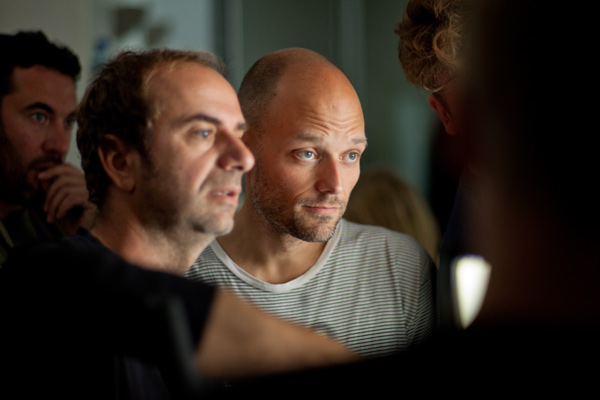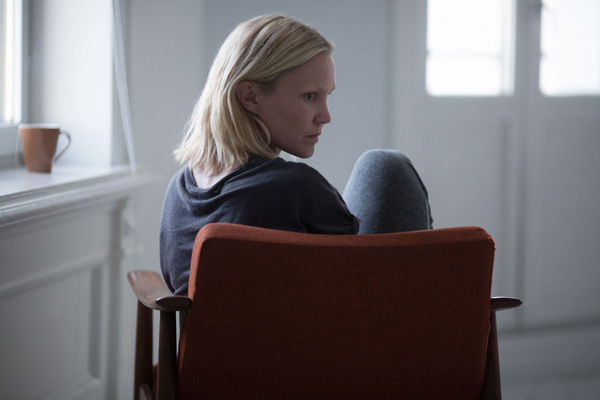IONCINEMA.com’s IONCINEPHILE of the Month feature focuses on an emerging filmmaker from the world of cinema. This September, we feature a filmmaker who doesn’t need much of an introduction to the readers of this site. Co-scribe on all of Joachim’s Trier’s films (Reprise, Oslo, August 31st and Cannes Main Comp selected Louder Than Bombs), Norwegian filmmaker Eskil Vogt sees his debut film, Blind open on Friday September 4th in NYC at the IFC Center and September 11th in L.A. at Cinefamily with Fandor releasing the film on VOD.
Considered among the best undistributed films of 2014, this import received instant acclaim at the back to back fests it premiered at early last year (it won Sundance FF’s World Cinema Best Screenplay and Berlin FF’s Label Europa Cinema). Below we discussed how he landed on the project, his writing process and visual strategies he employed. Here is our profile and make sure to check out his Top Ten Films of All Time.
Eric Lavallee: You are a product of videocassette era. During your childhood what films were important to you, and further along in your formative years, what films and filmmakers inspired you?
Eskil Vogt: I’m definitely a product of the VHS era. My mother was against us having a VCR in the house and this led to a frustrated movie hunger in me as a kid. I went to the cinema (I vividly remember seeing Back to the Future several times in the theater), but it was when my mother finally gave in and let my father buy a VCR the floodgates opened. At first it was mainly American films (they dominated the market in Norway as I guess they did all over the world) – I especially remember discovering films like The Breakfast Club, Evil Dead 2 or Repo Man… I eventually exhausted the US titles at my local video rental shop and as a last resort turned to the shelf with European movies. Soon I was frequenting the cinematheque in Oslo. Discovering Antonioni, Tarkovsky, Bresson, Godard, Resnais etc. was formative, as was Lynch, Woody Allen or Hitchcock. I still love watching all kinds of movies and I think you can see that in my films.
Lavallee: You’re first outings as a filmmaker were with short films produced during your time at La Fémis —- was wondering if you could highlight the moment when you wanted to pursue film/become a filmmaker.
Vogt: After we got a VCR I become one of those nerdy kids that had a whole library of VHS-cassettes with movies taped from the TV or elsewhere. There wasn’t really a moment or one single film that made me want to make movies myself, it was more like a slow realization, I enjoyed watching films more than anything and it dawned on me when I was 15 or so that people actually made these things as a living, that it might even be something I could do. I’m not from a filmmaker family at all, my father was a banker and my mother a nurse, so I had no idea how to get from that dream to actually making a film, but I that’s when I decided that was what I wanted.
Lavallee: What was the first kernel of an idea that you wanted to explore with Blind and was the humor always part of the film’s fabric?
Vogt: While I was developing another film to direct I was reading a book written by a friend of mine, Terje Holtet Larsen, where one of the characters is blind. The text was un-filmable, an inner monologue of someone who can’t see, but nevertheless I couldn’t shake it. When I put the other film aside and began to write, thinking about losing one’s sight, it just flowed out of me.
The clue was that the main character wasn’t born blind. She had lost her sight at a later stage and that meant she had a visual imagination and would constantly try to envision what was around her. And there was just so many interesting, exciting and funny things I could do with that as a filmmaker. I did a lot of research and met people that had lost their sight. Thanks to them the drama and grief of losing your sight became evident, but I didn’t want the sadness to completely take over and fought to keep the playfulness and energy that got me started. In many ways it is even more a film about our inner lives than it is about blindness – and that means every aspect of our psyche had to be represented – another reason to let the humor seep through the cracks.
Lavallee: The character of Ingrid follows in a string of insular types who also happen to write. When you take into account how your own writing process is like — which “muscle” is the most difficult to flex/flesh out: building your character set, creating guidelines for the thematic backbone you want to explore, the tone of the piece or development of the narrative strategy?
Vogt: In “Blind” everything fell into place quite effortlessly, I usually work it out in much more detail before starting to write, but here I worked in a more associative way and the themes and characters just fell into place and the structure of the plot – even though it is quite complex – was there quite early.
But usually what I have the most problems with is the narrative – I love inventing characters, scenes and formal concepts that explore the themes and I love writing dialogue – but I’m less interested in plot. For me the plot is kind of a necessary evil that gives structure to all the other stuff I love, it’s not a goal in itself. I guess that is partly the reason that the narrative structure of the films I write is quite weird and unconventional.
Lavallee: I quite liked the visually crafty, sleight of hand ideas used to express Ingrid’s playful, fantasy world. How did you go about spatially constructing the blueprint for those sequences?
Vogt: The rules of it was already laid down in the script and then we just had fun with it. Some of the most complex scenes were planned out in advance, but we had a lot of fun with it – even improvising on set. The only continuity we cared about was a mental one, that the sets and framing reflected whatever the state of mind of the blind woman was at that time. We moved things around from scene to scene and even from shot to shot. We’d have a prop or an extra from one scene pop up in another to create an echo. At times on set it was so chaotic that only the production designer and myself knew what we were doing. The script girl was afraid she’d never work again.
Lavallee: Can you discuss the collaborative process you had with you editor…
Vogt: I have written films before and people tend to say to me: you writers never get enough credit. But far worse is the way most people ignore the contribution of editors. Some people think editing is mainly a technical thing, taking out the claps, making cuts smooth or helping to choose the best take. But my editor on Blind, Jens Christian Fodstad was a key collaborator. An editor like Jens Christian does so much more than make edits, he is considering the larger picture, challenging me on how the themes are best expressed, shaping the rhythm, the feel and the meaning of the whole piece. As I both wrote and directed Blind I tend to get all the credit, but I consider Jens Christian the co-writer of the last version of Blind.
Lavallee: Can you discuss the collaborative process you had with your production designer….
Vogt: Jørgen Stangebye Larsen was the Production Designer and essential on Blind. He immediately realized the visual potential of the script and saw what I was aiming at with filming through the eyes and mind of the blind protagonist. He was ingenious on quite a small budget and would never say no to an idea for financial reasons. He kept proposing ideas and we pushed each other all the time to go further and take more and more chances. Jørgen knows that the style of a film is more than just the color scheme. It’s about the themes, the characters, the whole. Jørgen thinks like director himself and I love taking credit for his wonderful ideas on Blind.
Lavallee: Can you discuss the collaborative process you had with your dp…
Vogt: I was so happy that Thimios Bakatakis accepted to work on this film as the Director of Photography. I admired his work on Dogtooth and Attenberg in those films he displays an unusually good eye for composition, but also a simple and natural way of using light that I was really looking for. The strangest things happen in the films he chooses to film, but thanks to his natural lighting they never lose contact with reality and slide into total abstraction.
I told him how the blind woman doesn’t need to turn on the lights while alone and that I’d like to see the daylight in the interiors evolve from daylight til dusk around her. Only when her husband was there would the electric lights be switched on. Thimios took his cue from this and with the exception of a very few scenes he only relied on the light from the windows and the practicals already on the set. Thimios is a real artist – he never works on auto pilot, but wants to push himself and take risks. You can sense that shooting is sacred to him.





